Whenever I tag along with Beat on one of his work trips to the Bay Area, I’m struck with nostalgia-induced mania to do everything. It’s like that when I make a home somewhere and then leave. My old haunts become old friends, comforting in their familiarity, and edifying in the ways they change. I want to visit them all, to luxuriate in the memories and learn how the story evolved after I stopped following the narrative.
My friend Liehann let me borrow his OBED gravel bike. Within a week, I ground out nearly 200 miles, replaced the front brake pads, drained the electronic shifting battery, exhausted my overworked legs, and barely scratched the surface of everything I wanted to see. Two of the rides — one to the edge of the Pacific Ocean, another to the highest accessible summit in the Santa Cruz Mountains — took me to starkly different places both geographically and emotionally.
I was determined to see the ocean at least once during this visit to California, but it proved tough to carve out the time. Wednesday and Friday were the only days I was mostly free, and on Wednesday, I needed to work starting at 2 p.m. Tuesday ended with some stress regarding French contracts and scheduling conflicts, so my sleep was poor and I was wide awake before 5 a.m. I researched routes for the fastest and easiest way to reach the sea with the fastest and easiest means of transportation available to me — Liehann’s bicycle.
The nearest public beaches still seemed too time-consuming to reach via bicycle-friendly routes over the Santa Cruz Mountains. I came up with a 66-mile round-trip route, traveling almost due west, that would skirt along Highway 1 for just over a mile. I figured I’d have a nice ride over a mountain pass, skirt a few private ranches, and view a sliver of Big Blue from afar. It would have to be enough. I finally boosted myself out the door just before 8 a.m.
This route is such an incredible gem: Woodside to Tunitas via Kings Mountain and Tunitas Creek Roads. It’s a narrow strip of pavement winding through the cool shade of the redwood forest. There’s almost no car traffic. Little has changed in that regard since I last pedaled beside these quiet giants nearly 10 years ago.
When I drew my route on Strava that morning, I didn’t even realize I’d routed myself this way. I was inattentive and just assumed the line went over the busier La Honda because, well, because of gaps in memory and surly assumptions. I’d girded myself for annoyance and strain as I joined the frenetic commuter traffic streaming along Sunnyvale-Saratoga. But as I turned onto the equally busy Foothills Boulevard, I hugged the right edge of the wide shoulder and slipped into a pleasant trance. The traffic noise faded; the motion felt effortless. I was flying: 20, 22 mph without trying, stopped only by the occasional red light.
My watch guided me into the equestrian-dominated village of Woodside, where fast traffic is wholly unwelcome. Cars all but disappeared. I smiled at a flickering reel of memories from a dozen Woodside-based trail races, all my favorites, and then I saw a road sign. Kings Mountain Road! So this wasn’t La Honda. This was its smaller, steeper, but even more scenic sibling. And … Kings Mountain … to … what was the connector again? Tunitias, wasn’t it? That tiny road with the snack shack for cyclists near the end? That was my favorite road ride! I’d nearly forgotten. I never visited as much as I would have liked because Woodside seemed so far from where I lived in Los Altos. But … it’s not that far.
It’s weird how pieces reconnect in different ways once the original attachments are broken.
I barely noticed the 2,000-foot bump over Skyline and grinned the entire way down Tunitas Creek — 10 miles of screaming descent through a lush, enchanted forest. People pay good money for thrills far inferior to this. I streamed past the snack shack— no time to eat! — and turned onto the busy corridor of Highway 1.
I still couldn’t see the ocean. A half mile of climbing brought doubts that I would. Up was not the direction I wanted to go. I saw a pullout with a rusted gate that was cracked open. There were no “private property” or “no trespassing signs,” so I snuck inside. I pedaled along an overgrown track brimming with yellow wildflowers. I feared hidden thorns because I did not have time to fix a flat. After a short distance, I rounded a hill, where I saw finally it — just a sliver, as expected, but still in view. The Big Blue. The sight of its unbroken horizon filled my heart, and it was enough. I pedaled back to the highway, happy.
A half-mile later — just a quarter-mile from my turnoff back to the mountains — I saw an unmarked road dropping toward the coast. It likely led to private property, but it was worth checking out. I zipped down the road only to reach what I expected, a gate and a sign, “residents only.” The gate guarded a cute community — mostly mobile homes and small beach cottages with weather-worn paint and beautiful wildflower gardens. The Pacific was right there. I was close enough to see waves lapping the shoreline. The tide was coming in; the whitecaps were huge.
As I stood at the gate, gazing wistfully toward Big Blue, a voice startled me. “You want to go down to the beach?”
I turned to see an Asian woman, probably in her late 50s, sitting on a lawn chair in the shade of a large tree directly to my left.
“Oh, would that be okay?” I stammered. “I won’t be there long, I promise. I don’t have a lot of time today.”
“Oh, it’s fine,” she replied with a little laugh. “You have a bicycle, it’s no problem. It’s the cars that go down and get stuck.”
“Thank you! Thank you so much!” I responded perhaps too exuberantly, and zipped around the gate before she could change her mind.
The beach was deserted except for a single sandhill crane, one of those hulking red-forehead birds that look only a few generations removed from dinosaurs. It was close enough to converse with, but too far to capture a decent photo with my phone. I didn’t even try. Instead, I spoke to the crane in childlike squeals.
“Can you believe this place? Eeee! It’s amazing!”
I plopped onto the wet sand in my bike shorts, drew swirls with my fingers, and let the surf lap against my shoes. I couldn’t stop turning my head back and forth. To the south, sunlight shimmered in mist rising beside the headlands. To the north, enormous waves crashed against a sandstone monolith. With each explosion of white spray, I raised my arms and cheered. There was no other way to express this joy, which exploded from my body in erratic limb movements. You’d think I was a child who had never seen the ocean before. In that moment, that’s exactly what I was.
That inner child was overcome with the enormity of the world, the endless blue horizon, the powerful hydraulics, the enchanted forest that guarded this secret place, and the friendly roads that guided me here as though I were riding a magic carpet. I wanted to spend hours on this beach, epochs. But sadly, I was on a tight schedule.
I returned to the highway, turned onto Lobitos Creek cutoff, and commenced the long pedal inland. I climbed through the humid forest and dropped into the rain shadow of the Santa Clara Valley as temperatures soared into the mid-80s. But I felt none of the fatigue or discomfort I would have expected. I was still riding the high of this discovery — a secret oasis that my inner child can return to when things get hard.
The Wednesday ride had been so breezy that I felt overconfident about my energy availability for my full day off on Friday. One of the most prominent peaks in the Santa Cruz Mountains, Mount Umunhum, wasn’t open to the public when I lived here. Home to “The Cube,” a massive radar station built during the Cold War, the mountain was still undergoing hazardous material cleanup when I rode these hills more regularly. The Cube loomed ominously over the valley, ugly and mysterious, and I was eager to explore this forbidden place.
Now that Midpeninsula Open Space has opened the peak, I try to visit when I’m in the Bay Area. Usually, I ride a mountain bike through the steep and rocky hills of Sierra Azul, and it hurts like hell. Since I had a gravel bike and a little less desire to experience pain for pain’s sake, I thought I’d take the “easy” way up Hicks and Mount Umunhum Roads.
My overconfidence masked the reality that my legs were bone tired. After the 40-mile trail race on Saturday, I continued to do a bunch of cycling, walked everywhere else I wanted to be, and even completed two hour-long strength sessions at the gym. The legs generated loud complaints when the easy way up a 3,500-foot summit proved to be not easy at all. No, Hicks Road is hella steep — several sections top 17% grades, there’s a mile-long section over 13%, and it averages 10% even with a flat stretch along Guadalupe Reservoir. The bike’s electronic shifting had died on the long spin from Sunnyvale and settled in the granny gear. But that could be a problem for future me, because here, even the granny gear was killing me. I was weaving all over the road. Thank goodness there was almost no traffic on a Friday afternoon.
Mount Umunhum Road was just as bad, dropping its average grade only because most of the final 1.5-mile stretch was nearly flat. If you ever catch a whim to summit this mountain via road, just know you must climb from 600 feet to 3,300 feet in less than five miles, and it’s going to hurt like hell with less than fresh legs.
Anyway, I made it, said hello to the mysterious cube that remains locked tight, finally ate my lunch at 3 p.m., which improved my energy levels quite a lot, and clicked on my music player for the descent. As I rounded the summit, I noticed a plume of black smoke rising from a low hill to the north.
It was a small fire, but obviously brand new. Controlled burn? No, the afternoon was far too windy, hot, and dry for the fire to be intentional. The smoke looked like it might be east of my route, but then again, I wasn’t going to ride straight down this mountain. The road veered east. My pulse quickened. I am afraid of wildfires. Deeply afraid. The wind was blowing from the north, and the smoke plume seemed to bend in my direction. I did not want to be trapped on this mountain if a fire was approaching. I summoned my courage and plummeted toward it.
The descent accelerated rapidly, and with it my terror. On Mount Umunhum Road, I could still only smell the smoke, but Hicks Road was bathed in it. I didn’t want to stop, not even to pull a buff over my face or take a hit from my inhaler. When visibility dropped to a few feet, I had no choice.
I pulled both buffs over my nose and mouth — the one I use as a sweat band on my scalp and the one I wear on my wrist to wipe away snot. I rifled through my backpack for my inhaler and pulled the buffs down briefly to take a few hits. But it was too little, too late. My inhalations were shallow and increasingly panicked. My airways felt pinched, making it difficult to push air back out. I doubled over on the pavement, coughing, spitting, pounding my chest as though that would accomplish anything. The smoke only seemed to thicken. My eyes watered. My lungs burned.
This is my worst nightmare, my absolute worst nightmare. This is why I dread summer, why I want to move away from Colorado and leave the West altogether. But I can’t escape it. I know I can’t escape it. Not anywhere on this Earth in this brave new era of climate change. And this is how it ends. This is how I’ve expected it to end for years. For the few more seconds that I let myself sit with the conviction that I was about to die of an asthma attack — because asthma attacks feel like dying — I thought … “Yeah, of course, but how strange for this to happen here … in San Jose … in May.”
After several more seconds of coughing, I’d cleared enough space to push a few inhaler puffs into my airways. My head unfogged a bit, but I was still frightened and panicky, and I was still a long way from being safe. I briefly considered calling 911, but thought it would be quicker to pedal myself out of here as long as I remained conscious. The best way to do that would be to stop panicking. I tried to conjure Martin’s Beach, my happy place from Wednesday, but it was still just a vaguely formed placeholder in my short-term memory. My ancient iPod shuffle was playing music, so I turned my attention to the song I recognized. This was a good one, one I could focus on. I started it over, mounted the bike, and continued pedaling.
Along the edge of Guadalupe Reservoir, where grades are flat and pedaling is required, the north wind drove terrifying plumes of smoke across the pavement. I briefly closed my watering eyes and thought of nothing but listening to this song. “The Way” by Manchester Orchestra has a low-rolling, slightly erratic baseline. It matched my heartbeat, my shadow desperate breaths, which I slowed to match the rhythm. After each refrain, the drum pauses, and the singer draws out a long breath. Here I did the same: Took the pressure off my desperate spinny granny gear, coasted for several seconds, reminded my lungs to breatheeeeee, breatheeeeeeeee. When the verse picked back up, so did my legs.
Are you feeling like an anecdote?
Hovering to the hospital
Huffing fire and holy smoke
Does it start again?
I've been lost beyond the telescope
Goddamn diabolical
God forgive the prodigal
And let me start a-gaaaaaaain. (Coast and breathe) Oh, oh. (breathe)
Some number of “The Ways” later, probably not many, I reached the turnoff to Shannon Road. I meant to take Kennedy, but continued climbing on adrenaline until I was above the smoky smell and away from the plume. Emergency vehicles passed every few seconds. When I felt safe enough to stop again, I paused on a hilltop surrounded by $20 million mansions. Just out of view beyond a low ridge, the fire was dying already. At least four small planes and three helicopters circled overhead, dropping fire retardant and buckets of water scooped from the reservoir.
My throat felt like I had swallowed hot coals. My airways were open but strained. I stood on a curb and wheezily cheered for the aircraft, throwing my arms in the air and exhaling raspy squeals of glee when they dumped their loads. I was bursting with unbridled joy similar to what I’d felt at the ocean two days earlier, though this joy came from a markedly different place. The smoke plume was already much smaller than I’d seen from Mount Umunhum. Firefighters were attacking this blaze aggressively. “Of course they are,” I thought as I glanced at the sprawling estates surrounding me. So much money was at stake.
The Guadalupe Fire started on private land near Guadalupe Mine Road. It was first reported at 3:45 p.m. May 23 (I’m almost positive I noticed the smoke plume from Mount Unumhum before that time and damn, I should have called it in.) The fire burned quickly through grass, brush, and oak understory, spreading to 15 acres before forward progress was fully stopped before 6 p.m. By 10 p.m., San Jose fire crews successfully encircled the perimeter. The cause of the fire is still under investigation.
Meanwhile, I was overjoyed to be safe but still had to pedal my bedraggled body home. I’d accidentally diverted from my planned route and was well past Los Gatos before I realized I had no idea where I was. Too deep into my adrenaline crash, with too many holes in my memory to figure it out, I asked Google to tell me where to go. The phone directed me onto a scary corridor between the West Valley Freeway and railroad tracks. It wasn’t even a trail, just a strip of rutted, sunbaked dirt — the kind of hidden public right-of-way that would probably be littered with hypodermic needles and used condoms if it were anywhere else but Saratoga, California.
I still didn’t like being there, and then I had to push the bike over train tracks for a short distance. This second small but unexpected scare used up the rest of my adrenaline. After that, I had nothing left to use but tiny, useless gears and nothing left in my body but raw emotion. So I let myself sob. Big, heaving sobs as my legs spun wildly and then coasted slowly down the confusing streets. I must have looked like I was having a nervous breakdown, but I did not care about the people who could see me sobbing.
I was still in tears when my friend Liehann texted to ask if I wanted to join them for dinner with a party of 17. I couldn’t think of anything I wanted to do less. Except maybe ride back into the fire; that would be worse. I replied that I’d had a rough ride and would need some downtime. Beat saw this message as well. When I returned to the house, he immediately handed me a Super Big Gulp of icy Diet Pepsi from 7-Eleven. Instead of going out with the group, he offered to DoorDash fresh sushi. I don’t know if I’ve ever loved Beat more. I mean, I love him all the time, and then we worked through the French-language legalese on a purchase agreement for a chalet in the Alps this week, which is beyond exciting (there can be wildfires in the Alps, but not everywhere and always like the American West). But on this evening, with a tanker of soda, sushi, my sympathetic husband, and fresh air to breathe, I had everything I’d ever need.
The following day, Beat and I had planned a 21-mile run through a couple of the last remaining old-growth redwood forests in the Santa Cruz Mountains. It’s a deceptively tough route — dropping from Skyline Ridge onto lesser trails that are steep, overgrown, strewn with broken branches, and sometimes blocked by deadfall redwood trunks as wide as I am tall. This time of year, it’s a poison oak gauntlet. When I woke up Saturday morning, my lungs still felt like they were on fire. My breaths remained short and wheezy. It would have been reasonable to skip such a long, arduous physical activity, but I refused to let this rare opportunity lapse. My soul needed an immersive forest bath, so my body would have to rally.
Sometimes, fate is cruel and throws a tiny wildfire directly into your asthmatic path. But also, fate can be kind when it spreads a healing marine layer over your misguided long run. We arrived at Skyline Ridge to temperatures in the mid-40s and a thick blanket of fog streaming through the oaks. Fog rain dripped from branches as we broke into faster-than-anticipated speeds to stay warm.
But the air! The air was saturated in cool moisture, filling my ragged lungs like balm on a burn. I could breathe, and the more I breathed, the better I felt. Beat, still tired himself, didn’t seem too fussed about running as fast as possible. He kept a pace that allowed me to stay near him, and I loved him for this.
In a coastal redwood forest where the air is outwardly healing, Old Tree is a healer of souls. How can you not revere a living being that has thrived for more than 1,200 years, surviving countless wildfires and the 19th-century clear-cutting that razed more than 96% of these forests? Those old-timey loggers left only oddly shaped and inaccessible trees, many of which remain largely inaccessible to this day (this is the reason why we must run miles through a poison oak gauntlet to reach Peters Creek.) Old Tree is much closer to the road, but we like to make our 21-mile pilgrimage to see it. Old Tree deserves that much from us.
Everything that happened during the past week in California was a lot. But I’m glad I left my heart and memories to rest here for now — pausing at the foot of Old Tree and also on top of Black Mountain during a pleasant joy ride with Beat and Liehann — and not sobbing and sputtering through smoke-filled lungs in a daze in Cupertino.
Life is a wild rollercoaster ride. The lesson remains — when you hit the low points, keep going.

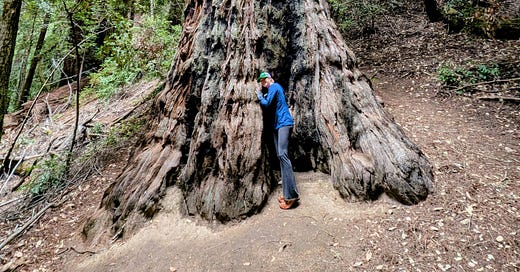



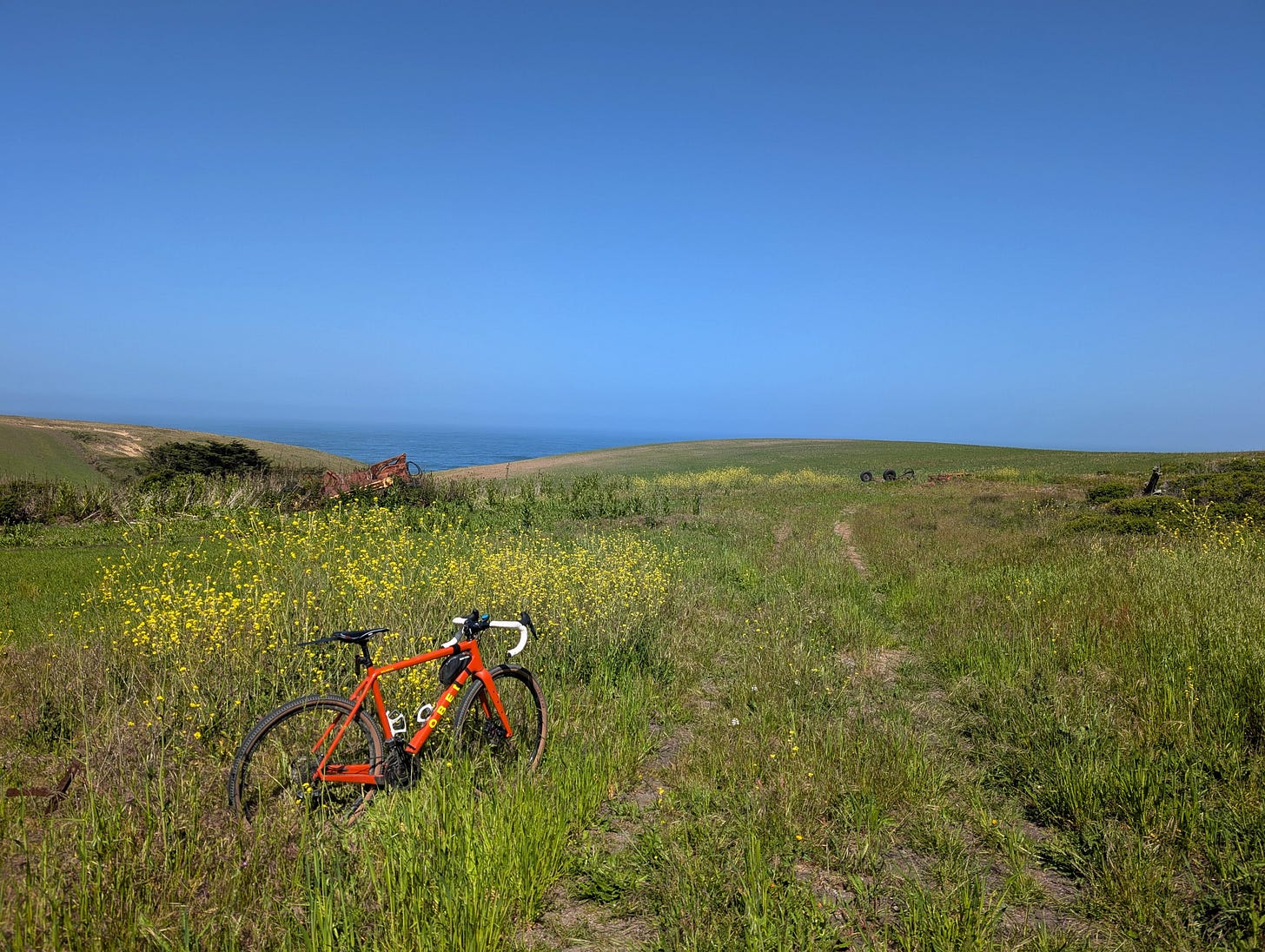
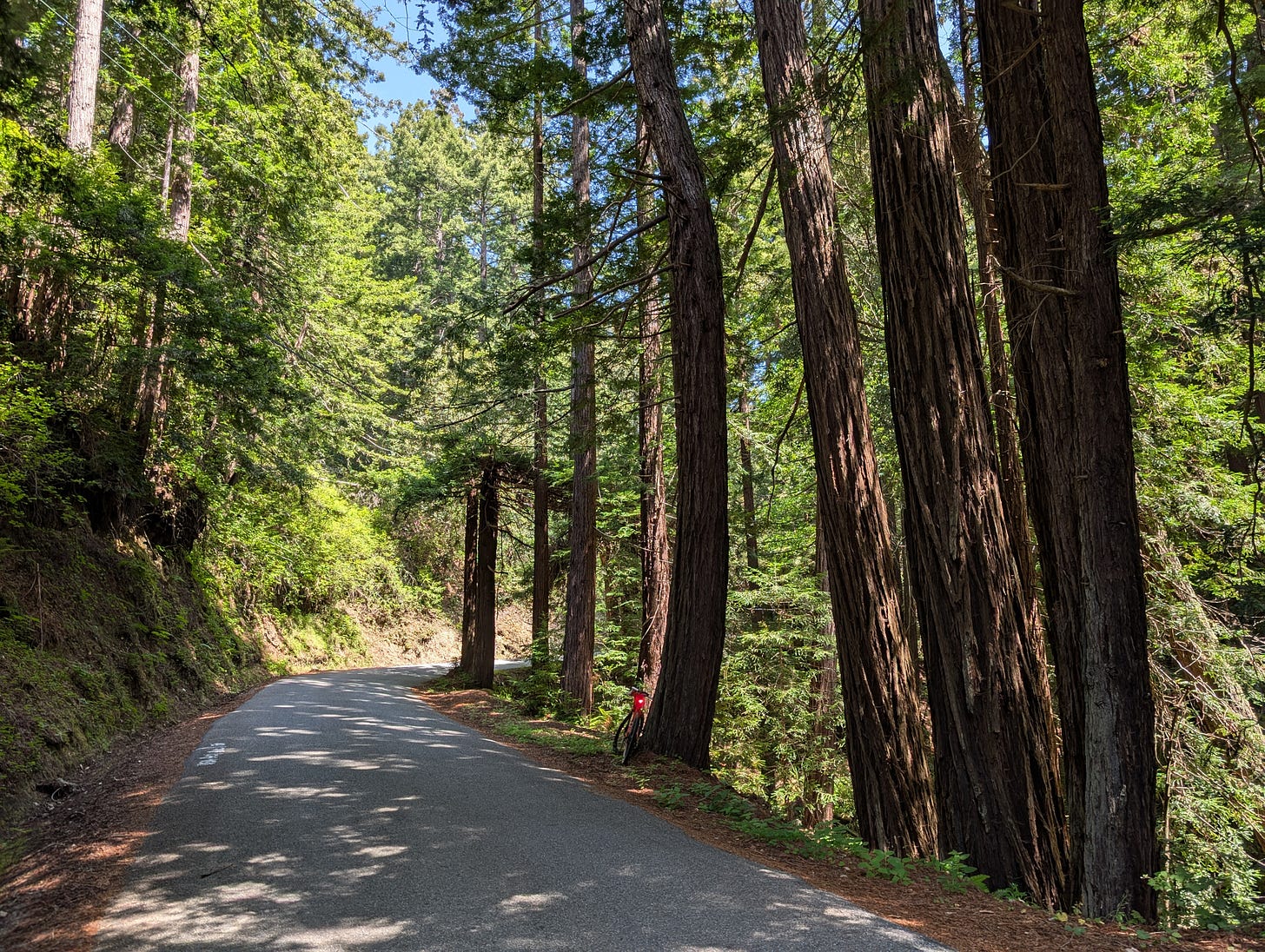
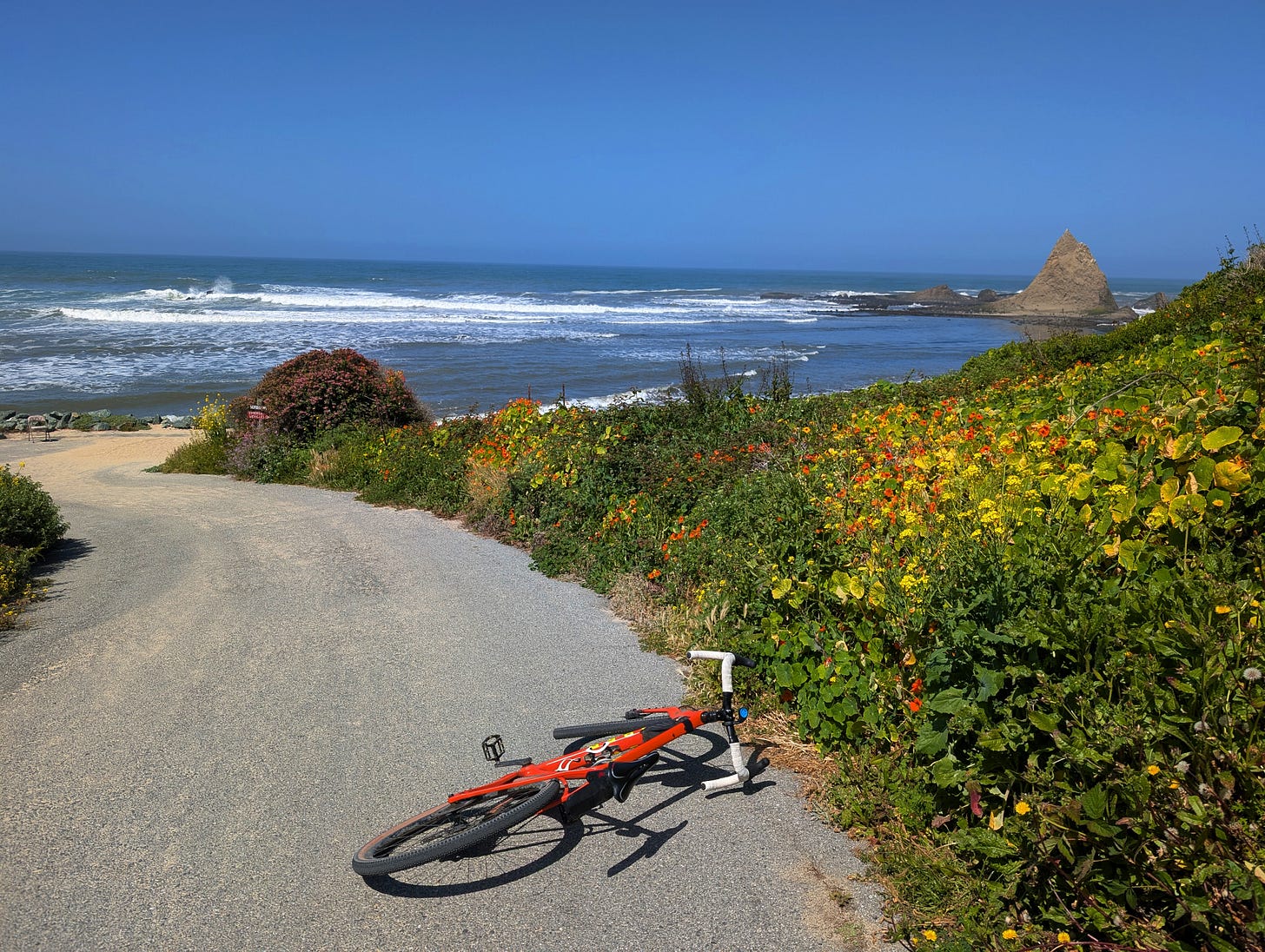
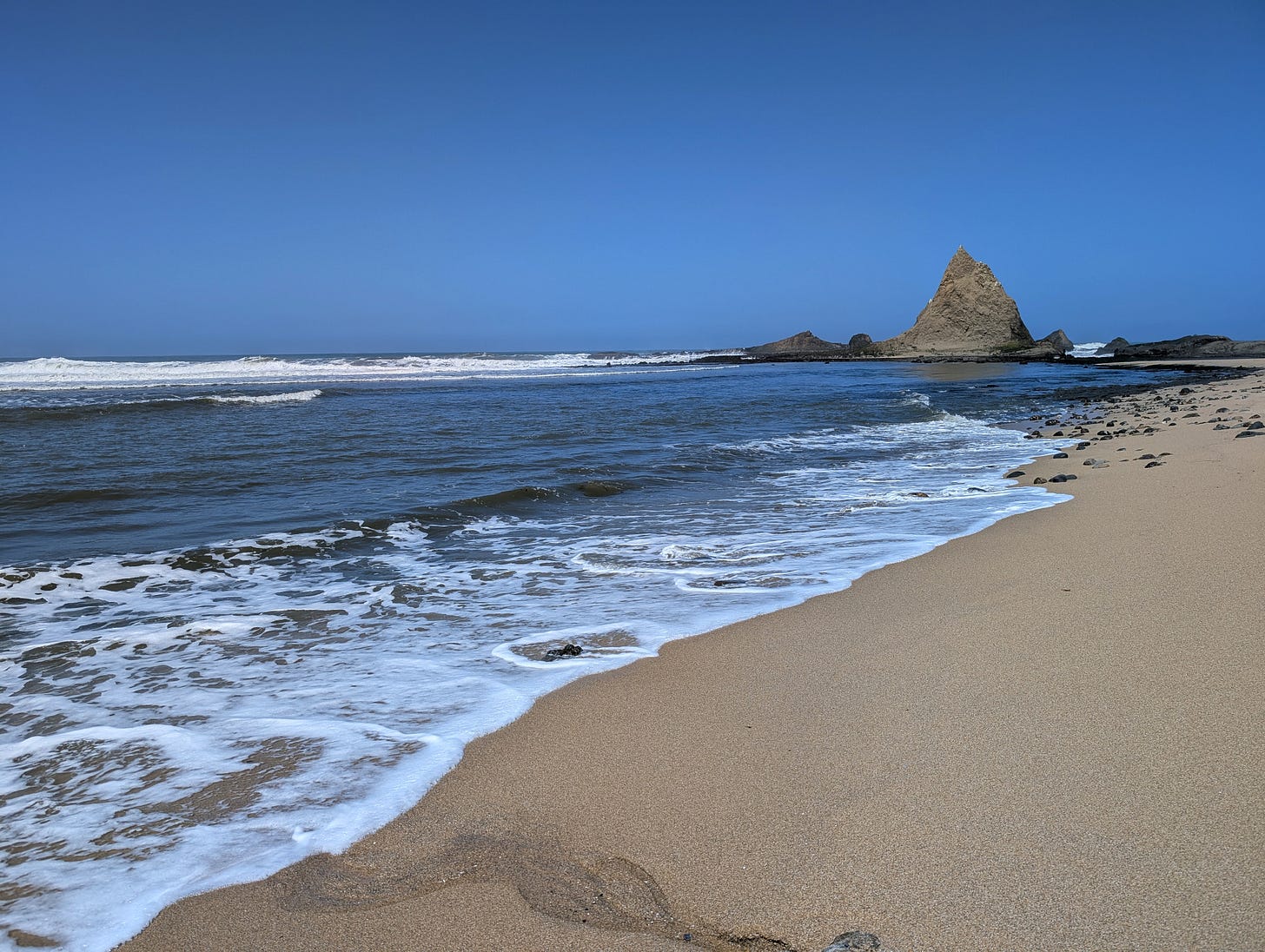
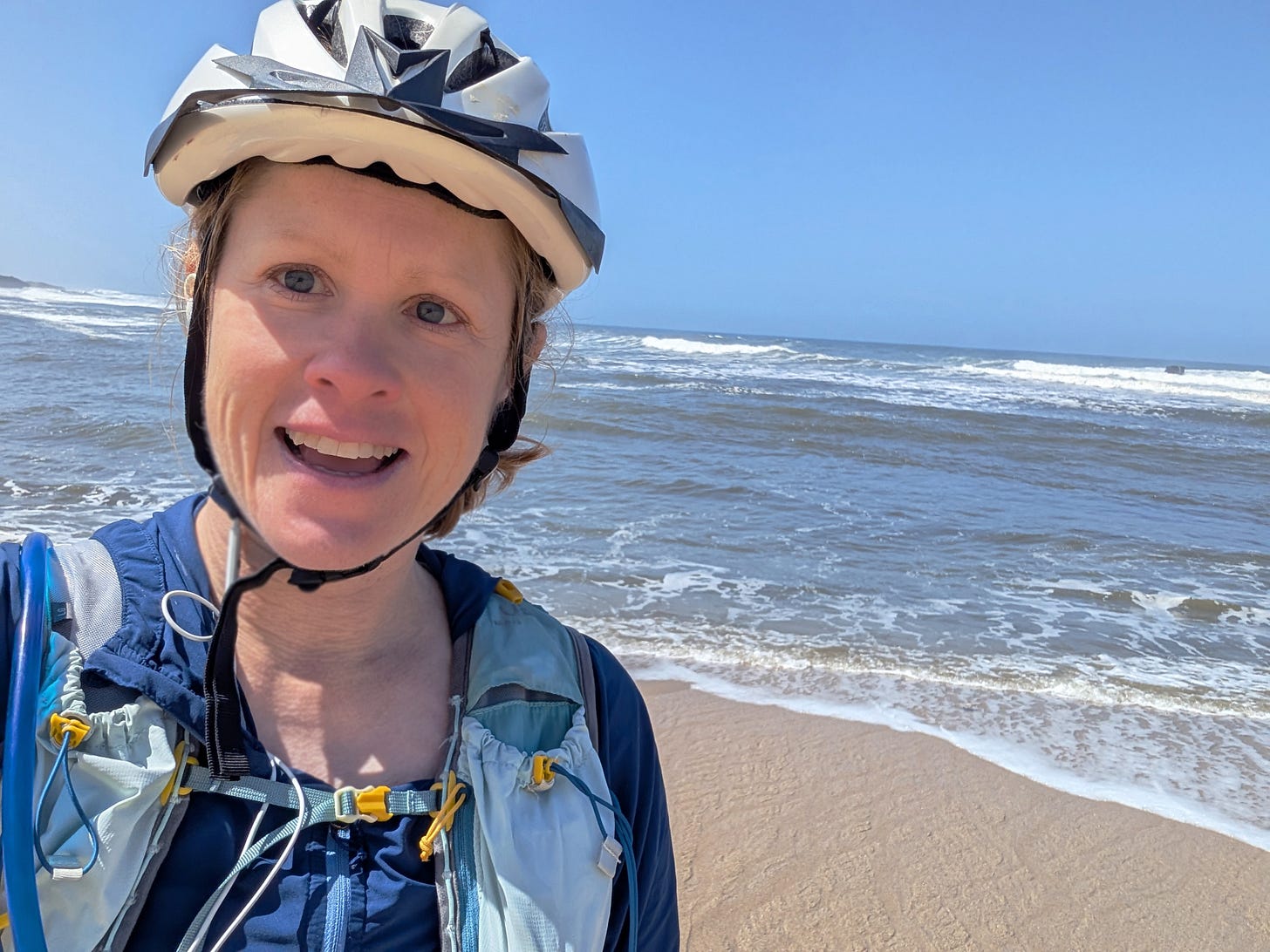
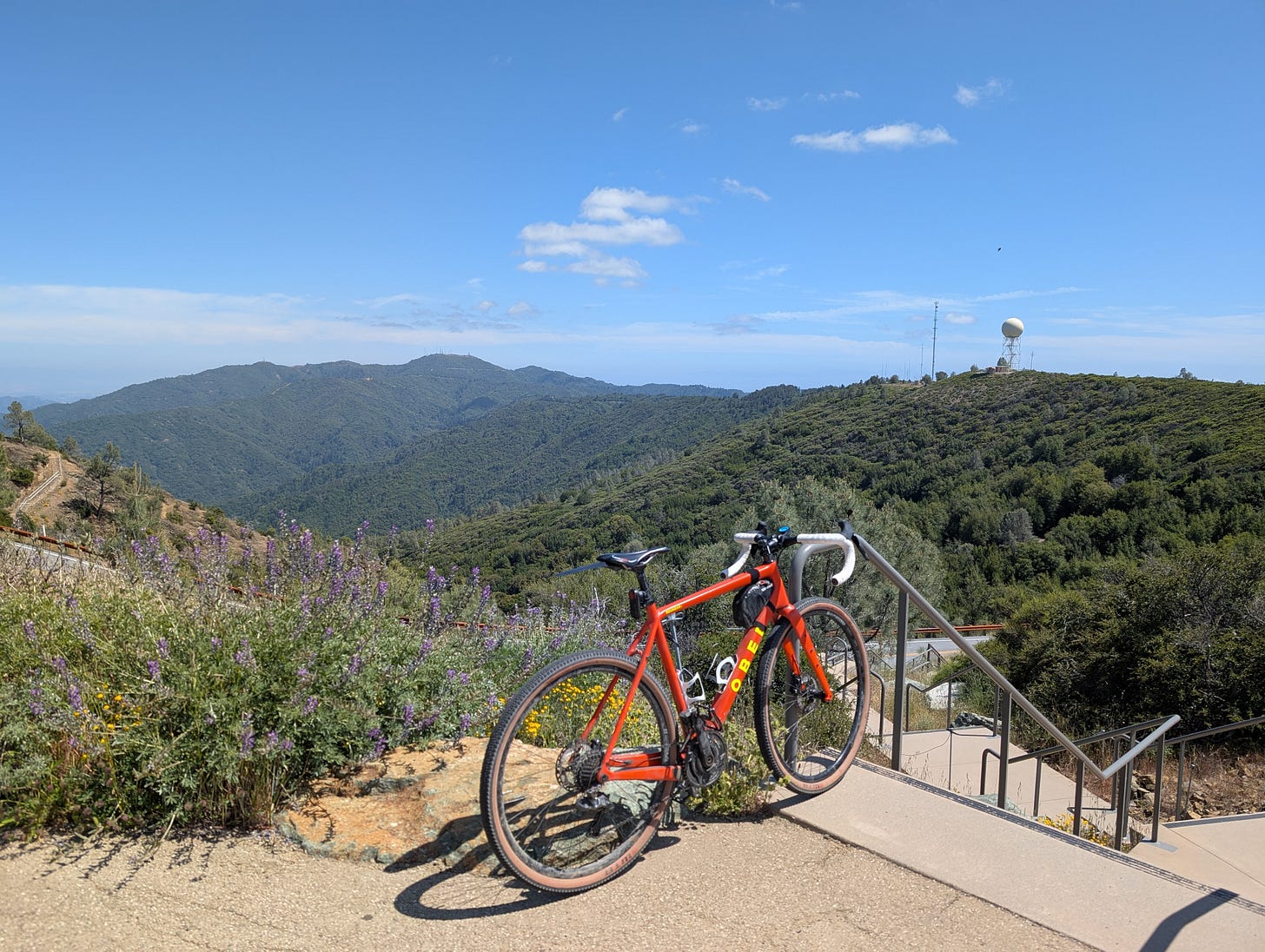
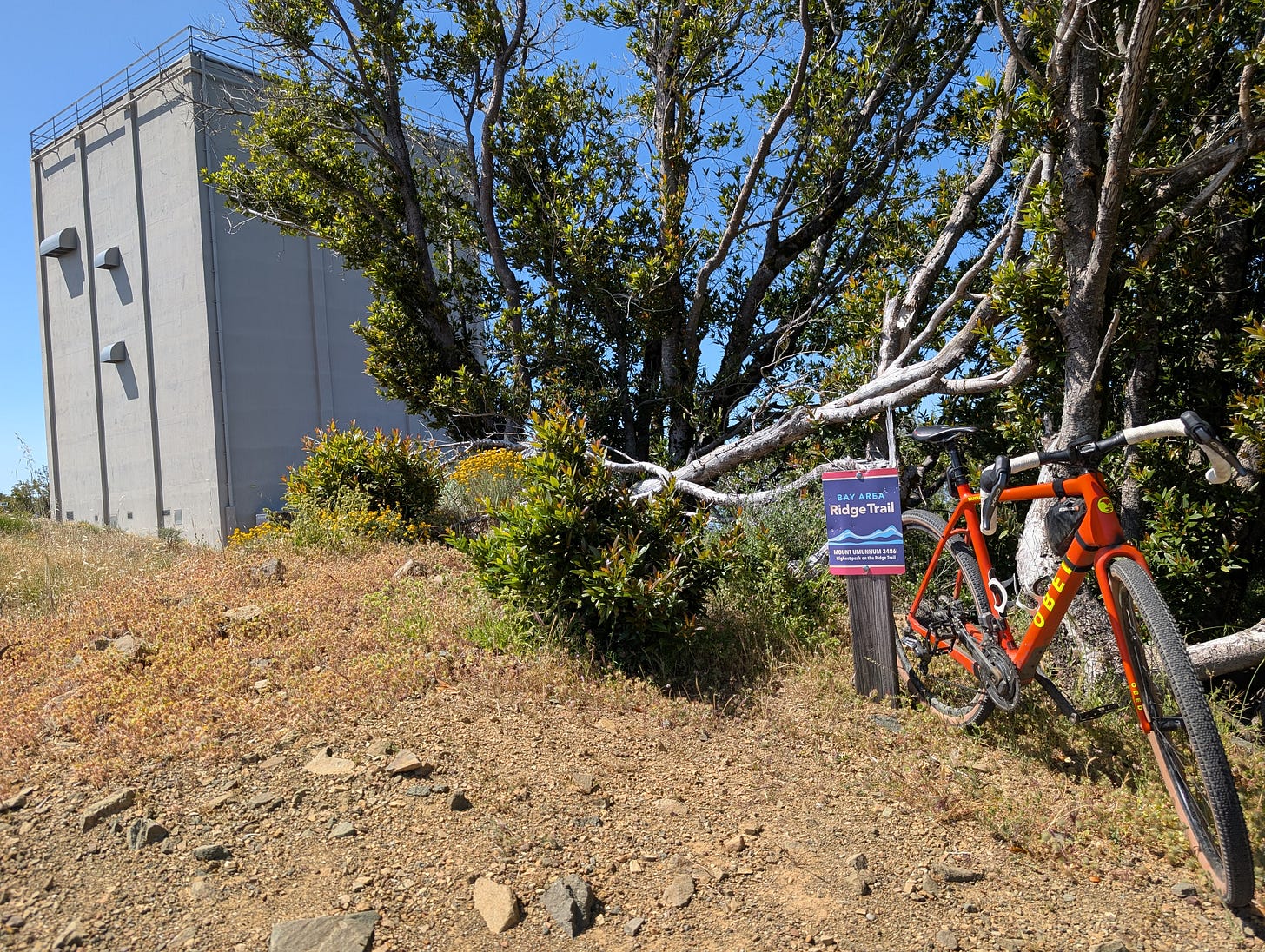
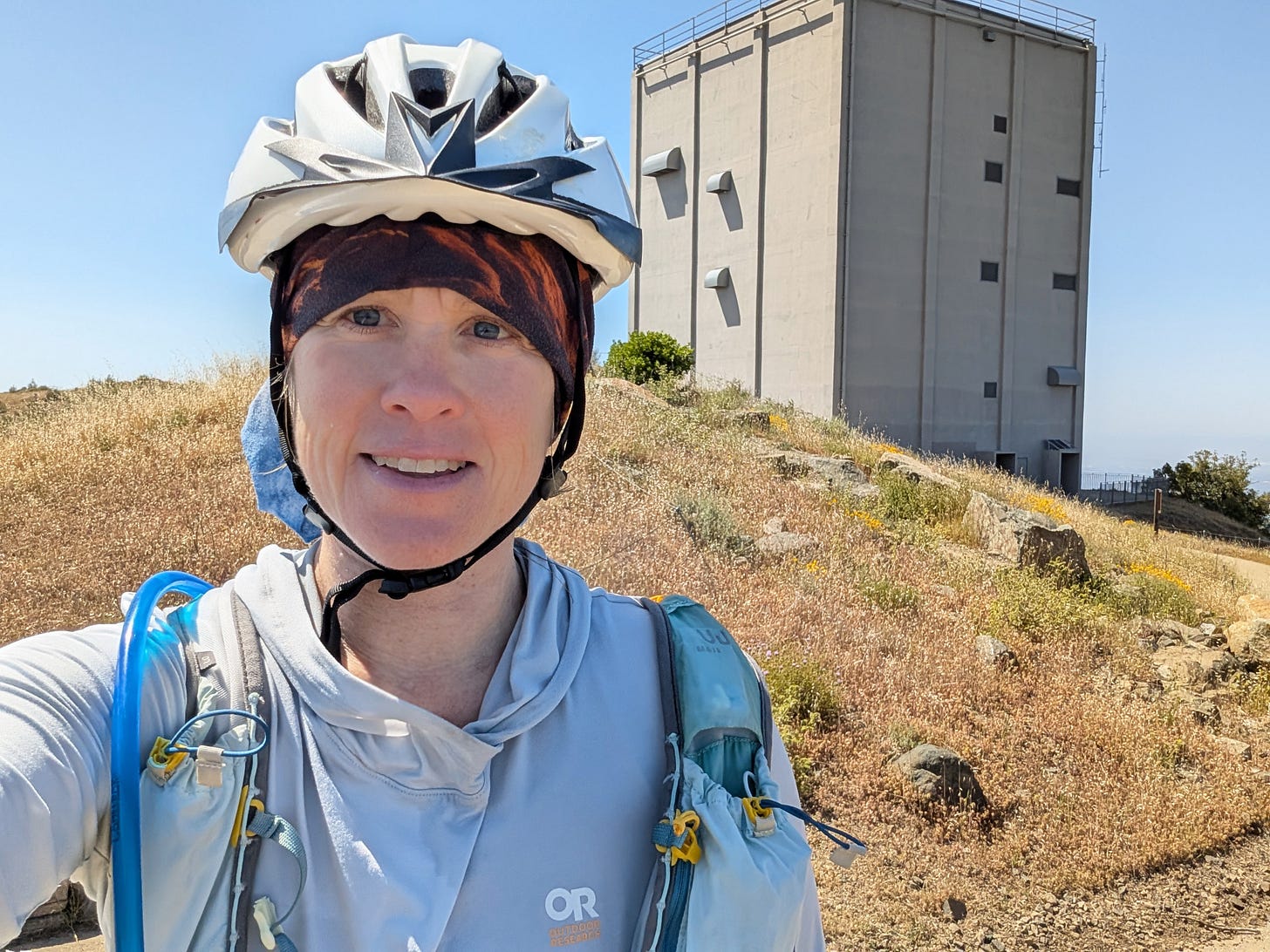
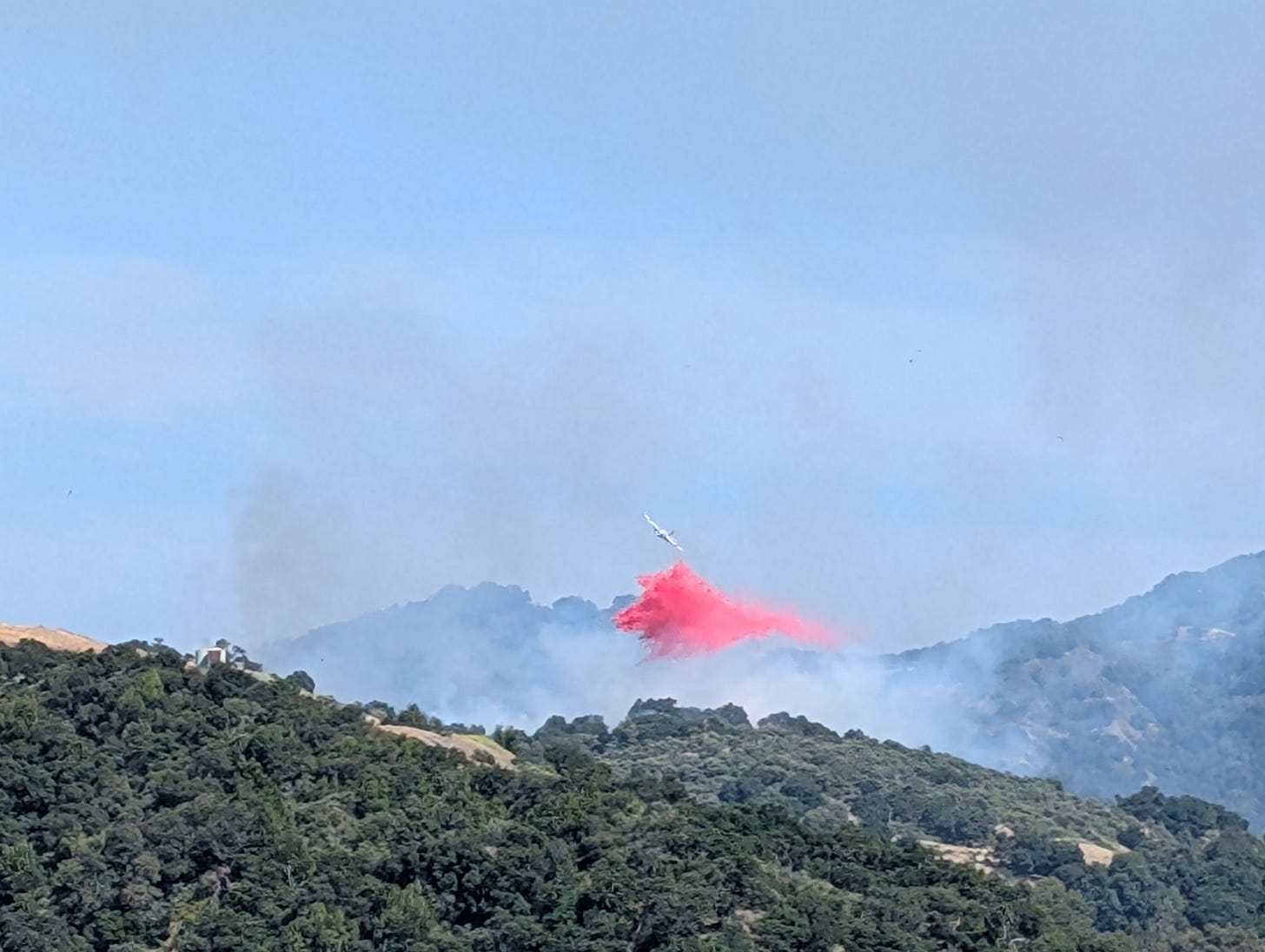
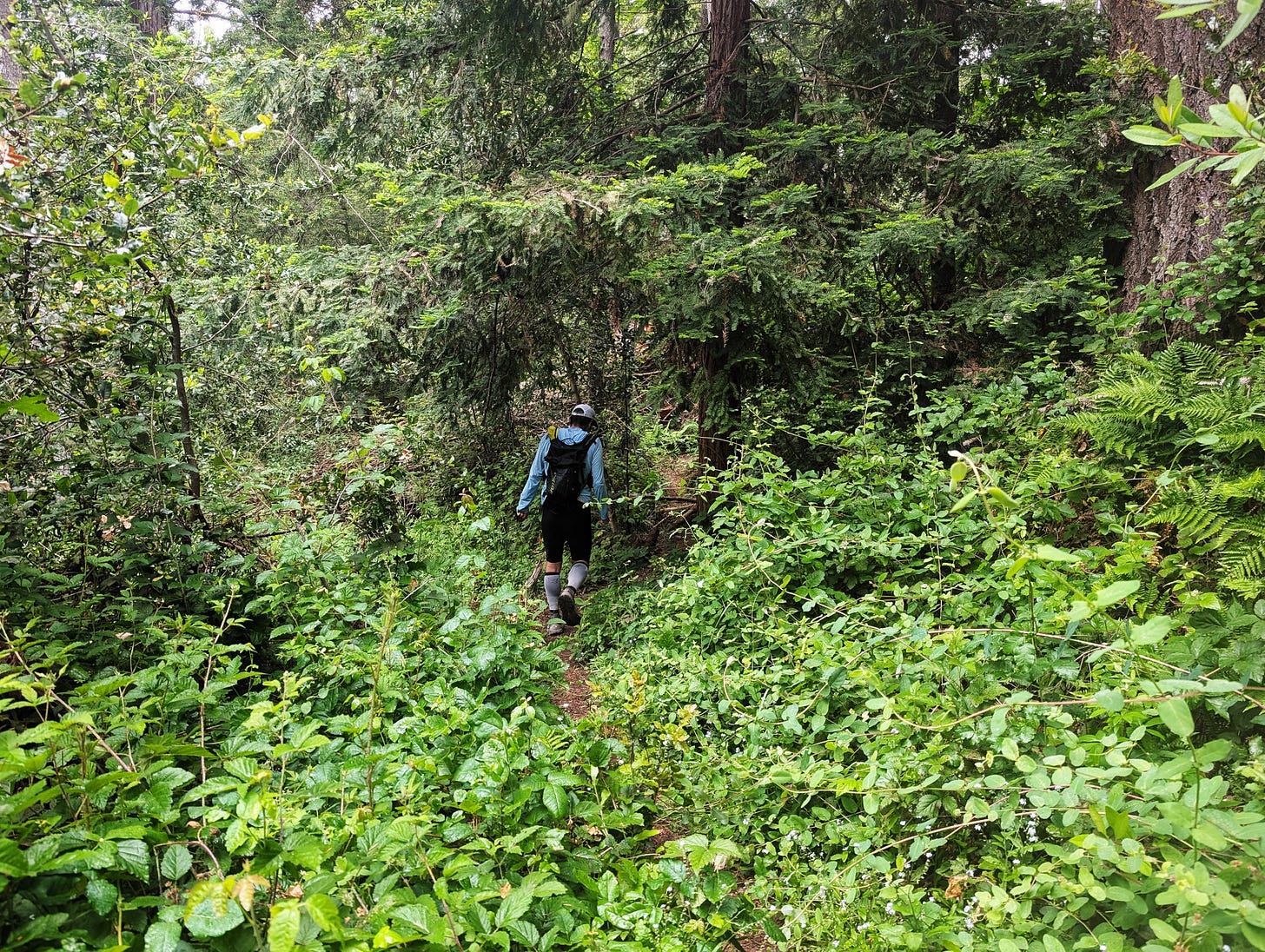
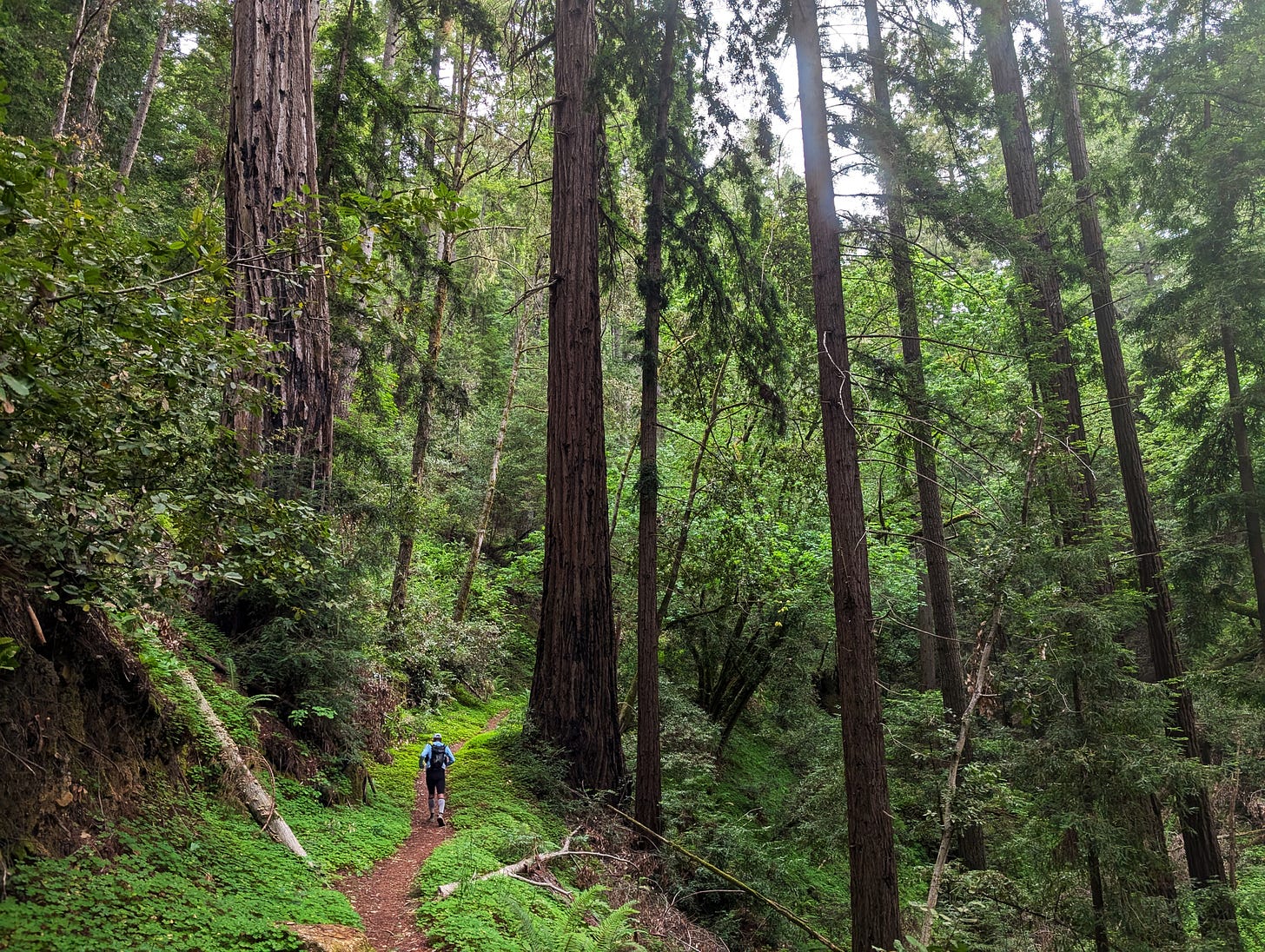
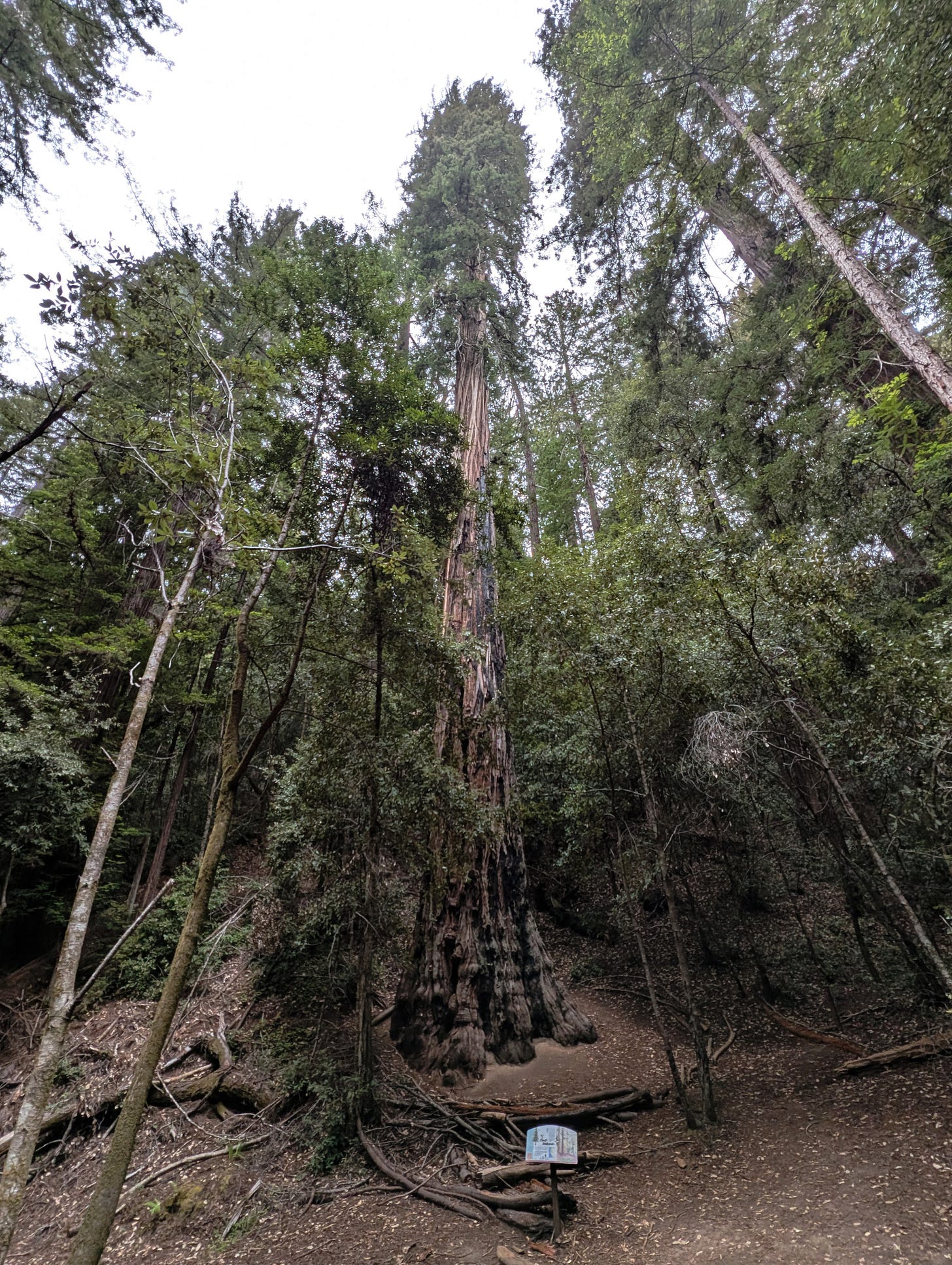
Loved this so much , sorry you couldn’t breathe and become frightened, I would have been petrified!!
This…. Was a beautiful adventure, I loved it for you and for me to read! Wow! 🤩